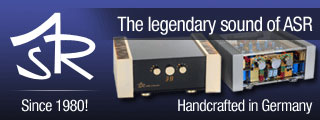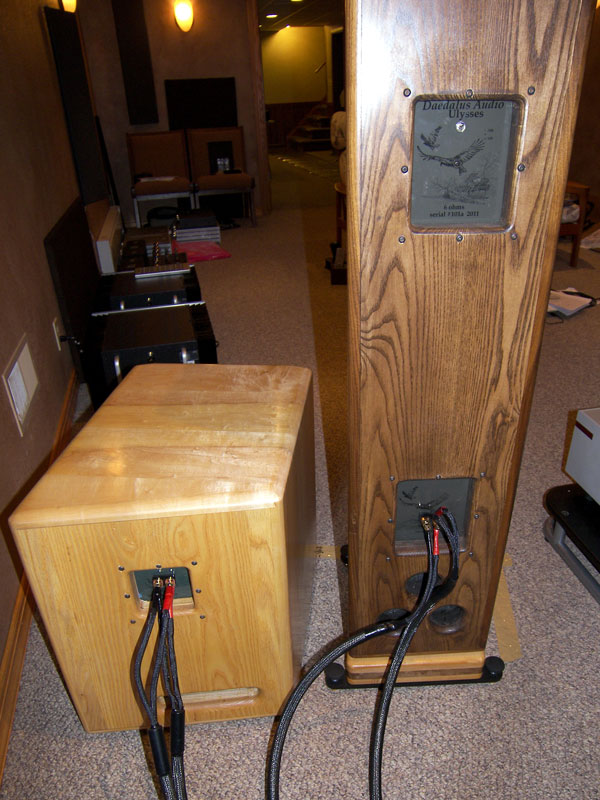Here, then, are two systems I set up with the Ulysses/BOW system:
Traditional System
Simaudio Moon Evolution 750D
Eastern Electric Minimax DAC Plus with Burson or Dexa discrete Opamps upgrade
VAC Signature Preamplifier MkII
-The high pass crossovers L/R used with the Ulysses are placed on one pair of L/R outputs of the preamp leading to the amp used for the Ulysses
VAC Phi 200 (two, used in Stereo mode; one for Ulysses and one for BOW)
Cabling: Clarity Cables, with the Ulysses speaker cables doubled
Alternative System
Simaudio Moon Evolution 750D
EE Minimax DAC Plus with Burson or Dexa discrete Opamps upgrade
(Here is where it gets unconventional)
Audioquest RCA 1 to 2 “Y” Adapters used on outputs of the Minimax DAC Plus*
-The high pass crossovers L/R used with the Ulysses are placed on one L and one R output of the Adapters; the interconnects lead to the amp used for the Ulysses are attached to these fixed crossovers, which take only RCA interconnects
– the remaining respective L and R outputs of the two Adapters are linked via interconnects to the L/R inputs of the BOW active crossover
* The use of adapters and the particular manner in which the interconnects must be connected may sound messy, but it is actually an elegant solution as the source goes direct into the integrated amps, thus bypassing one set of cables and a preamplifier!
Pathos Classic One MkIII tube hybrid Integrated Amplifier set to Stereo (one amp for Ulysses, one for BOW)
The listening sessions
I vastly enjoyed both of these systems and was able to tune them to my satisfaction. The result sonically of using the BOW with the Ulysses was singularly splendid. I consider Daedalus to have hit the mark when it comes to producing a transducer capable of top end sound. From the website the Ulysses is described as having, “…real life dynamics, pin point imaging and a huge, detailed soundstage. Flat out breathtaking in its realism, clarity and power.” Is that description accurate or Ad fluff? In my use it is accurate; the Ulysses is well above average in those respects.
I had previously noted the lack of cabinet resonances from the Ulysses even when playing LF laden music. Four 80 East and Peter White are good artists to introduce some LF to one’s system without an assault being made upon the ears. When playing these music, at no point did the Ulysses’ cabinet bark. With such a mightily reinforced cabinet one can hear precisely the degree to which the bass drivers are working. This is highly advantageous as it is abundantly evident that they are not straining anywhere near as much as the myriad of speakers with 5” bass drivers. There was a relaxed nature to the bass without the “popping” associated with more diminutive bass drivers. The triple ports at the back of the speaker did a fine job of relieving the strain on the bass cones while dispelling the cabinet’s internal pressurization without chuffing. However, there was no mistaking how right and complete the speaker system sounded when the BOW was used.
I appreciated the tonality of the Ulysses/BOW whether the bass was electronic or acoustic. One of the most difficult pieces for any rig I test is Apocalyptica’s Enter the Sandman, in which three Cellos fairly howl, the center one screeching to beat a banshee. The bass line via other systems often is drowned out by the crowding of having three cellos played in a reverberant recording space, but it was distinct and ripe to a degree that the Ulysses made it approach pleasantness, which is a herculean feat.
The Ulysses’ top end is the best I have heard from a speaker utilizing a soft dome tweeter. My struggle with soft domes over time has been, well, their softness. They have always struck me as forgiving but not terrifically compelling devices. Lou has addressed the “softie” soft dome issue by making a binary tweeter system. This brings just the right amount of zing to cymbals and chimes. At the same time they greatly reduce the glare of tweeters like ring radiators or Magnepan’s quasi-ribbons. More highly resolving tweeters over time can become irritating as the stridency starts to get to me.
I am not saying the high end of the Ulysses is incapable of being tilted towards brightness. Only at one time did I feel the treble was too keen, when I first set up the Pathos Classic One MkIII integrateds. I had inserted the fixed crossover, thus moderating the bass below 55 Hz as the BOW was also being used at that time. I had the tweeter attenuation set to +2 dB, and heard the sizzle of treble such that if I turned up the speaker I began to tighten my face, a sure sign of impending listening fatigue. Then I recalled that I could double the speaker cables, and doing so brought more definition as well as more relaxed treble, a perfect outcome. I did not have to lower the tweeter attenuation setting and kept it there the remainder of the time I used the Pathos amps. It should be noted as well that I did not have to lower the +2 dB attenuation when using the Jones Audio or Pass Labs amps; truly, the Ulysses is a delightfully deft speaker.
Driver consistency and coherency
Coherency between driver sets of the Ulysses is excellent, and I believe much of that coherency is due to the consistency in the drivers’ nature. Lou’s philosophy is that by staying within the same technological family of drivers, i.e. all dynamic, the odds of achieving superior coherency is improved. The handoff between driver sets was seamless as possible without resorting to a single-driver speaker, as evidenced when hearing Phillip Saesse’s keyboards and piano or Brian Bromberg’s acoustic bass.
One of the strengths of the Ulysses is the selection of a 5” full range driver as midrange. Historically, I have not been overly impressed by 5” or smaller mids, such that I will often discount a speaker entirely as a potential reference if the midrange is too cramped. By that I mean lacking in fullness and or a sense of utter ease. One of my greatest hesitations in reviewing the Ulysses revolved around the 5” mid, as I was concerned that it might not get past that cramped sound. However, each time I heard it at shows it did not strike me as such. So also, during the review period voices and acoustic instruments did not give the impression of being smallish or constrained.
A terrific boon to this was the high sensitivity of the speaker at 98dB, which injects excitement into the performance of the speaker. Joss Stone was snappier than I recalled when heard on 4 Ohm 80-something-dB-sensitivity speakers. The Ulysses couldn’t manage easily the LF her music creates – no speaker with 8” bass drivers would – until the BOW was added later. However, her breathy and nasal character of her singing carried its own type of sultriness.
Purist experience
There are a tremendous number of commendable, shall we say “honorable mention,” speakers in the HiFi universe. Most of them can be relatively ignorable as they neither impress sonically or seem prefab. Alternatively, the Ulysses and BOW exude a purist audio aura; they look, but more importantly sound like they are serious devices to extract no-nonsense sound from a recording. And yes, older recordings were resplendent. With lush hardwoods in a non-resonant cabinet, high sensitivity with closely matched driver sets, and an eminently amenable tonality which is agreeable to solid state as well as tubed amplification, what about the Daedalus is not to adore? People who have been around audio for a while, who look for a high degree of amp and speaker synergy and who seek superior dynamics even with a lower powered amp but who do not want to sell the farm to obtain it, bring up Daedalus in forums as a primary consideration.
They’re right. The Ulysses and BOW system are “purist-worthy” and have confirmed my show experiences as not being a fluke. To the casual observer the Ulysses/BOW pairing appears a fine effort from an obscure small company home grown on U.S. It shows its true pedigree by hitting the performance bullseye, proving it and the BOW are speaker royalty. It is a supremely good expression of a full range, higher efficiency speaker and was one of the exceptionally few products I have handled as a reviewer which satisfied every major expectation I had of it.
They talk about speaker systems which could be the last you own. Most of the time that’s not true, not if you are a purist and extremely fussy as such speaker systems usually carry at least one compromise, or perhaps “shortcoming.” Not the Ulysses and BOW. At the price point it is a “no compromise” product and a perfect fit for the uncompromising audiophile!
(That is not the end of the tale, however, for there is more to this “epic” than first appears. A second volume is in the works, and it does directly pertain to why I will do my best to afford this speaker as a reference.)
Associated Components:
Source: Simaudio Moon Evolution 750D DAC/Player; Cambridge Audio 840C; Denon 2900 Universal Player; Sonos Digital Music System; Oppo DV-970HD
NAS: Buffalo Linkstation 500G
DAC: Eastern Electric Minimax DAC Plus with Burson and Dexa NewClassD Discrete Opamp Upgrade
Preamp: VAC Renaissance Signature Preamplifier MkII; Purity Audio Design Silver Statement; Cambridge Audio 840E
Amps: VAC Phi 200; Pass Labs XA160.5 Monos; Jones Audio PA-M300-1-2 Monoblocks; Cambrige Audio Azur 840W
Integrated: Pathos Classic One MkIII stereo tube hybrid (two units bridged to mono); Peachtree Audio Nova
Speakers: King’s Audio Kingsound King; Legacy Audio Whisper DSW; Kings Audio King Tower Omnidirectional; Daedalus Audio Ulysses; Eminent Technology LFT-8b
Subwoofers: Daedalus Audio BOW
IC’s: Clarity Cable Organic RCA/XLR; Tara Labs RSC Air1 series 2; Wireworld Equinox; Wireworld Silver Eclipse; Wireworld Platinum Eclipse
Speaker Cables: Clarity Cable Organic Speaker; Tara Labs RSC Air1; Wireworld Equinox 5; Wireworld Silver Eclipse
Digital Cables: Clarity Cable Organic Digital; Tara Labs RSC Air 75; Wire World Startlight 6; Wireworld Gold Starlight 5, Wireworld Gold Starlight 6
Power Cables: Clarity Cable Vortex; MIT Oracle ZIII; Tara Labs RSC Air; Xindak PF-Gold; Wireworld Stratus 5, Electra 5 and Silver Electra
Power Conditioning: Wireworld Matrix Power Cord Extender; Tara Labs ISM Power Screen; Tice Audio Solo
Manufacturer’s Comment:
I would like to thank Dagogo and Douglas Schroeder for an excellent and well crafted review, one that captures my design philosophy spot on. As he mentions the Ulysses have been around for a few years and have been reviewed as a full range stand alone speaker yet when they are paired with the BOW the system, they form what I consider a ‘statement’ system, and I am thankful for the opportunity to have them reviewed as such.
BTW, the BOW are designed to mate well with any of my systems but were designed with the Ulysses in mind. As for placement, there was a small miscommunication on that, yet interestingly Douglas came to what I recommend for placement with his own experiments.
One correction as to technical specs is in regards the tweeter level switch. This is actually +/- .5dB, a very subtle shift but enough so that in some rooms or systems it can make the needed adjustment without noticeably skewing the response.
Lou Hinkley
Daedalus Audio
Thanks again and I hope that Douglas enjoys his new speakers for many years.
- ← Previous page
- (Page 3 of 3)


